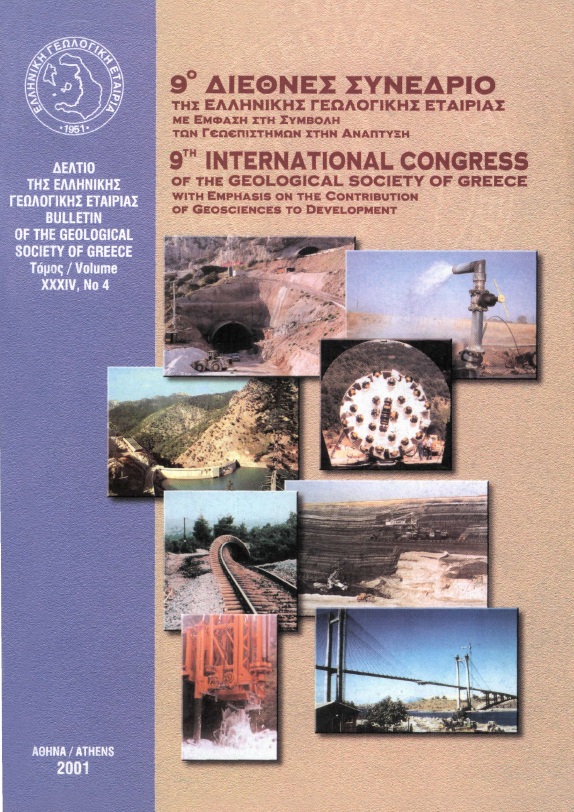DETERMINATION OF FAULT PLANE SOLUTIONS USING WAVEFORM AMPLITUDES AND RADIATION PATTERN
Περίληψη
In the present work a modified version of the program FPFIT (Reasenberg and Oppenheimer, 1985) is developed, in order to improve the calculation of the fault plane solutions. The method is applied on selected earthquakes from short period waveform data in the Mygdonia basin (N. Greece) as recorded by the permanent network of the Seismological Station of Aristotle University of Thessaloniki during the period 1989-1999. The proposed modification of the FPFIT program was developed in order to minimize the derivation of multiple solutions, as well as the uncertainties in the location of Ρ and Τ axis of the determined fault plane solutions. Compared to the original version of FPFIT the modified approach takes also into account the radiation pattern of SV and SH waves. For each earthquake horizontal and vertical components of each station were used and the first arrivals of Ρ and S waves were picked. Using the maximum peak-to-peak amplitude of Ρ and S waves the ratio Pmax/(S/\/2max+SE2max)1/2 was estimated, where S/Vmax and SEmax are the maximum amplitudes of the two horizontal components (N-S, E-W) for the S waves and Pmax is the maximum amplitude of the vertical one for the P- waves. This ratio for the observed data, as well as the corresponding ratio Prad/iS/Aad+SlAad)1'2 of the synthetic data was used as a weight for the determination of the observed and theoretical P-wave polarities, respectively. The method was tested using synthetic data. A significant improvement of the results was found, compared to the original version of FPFIT. In particular, an improved approximation of the input focal mechanism is found, without multiple solutions and the best-estimated Ρ and Τ axes exhibit much smaller uncertainties. The addition of noise in the synthetic data didn't significantly change the results concerning the fault plane solutions. Finally, we have applied the modified program on a real data set of earthquakes that occurred in the Mygdonia basin.
Λεπτομέρειες άρθρου
- Πώς να δημιουργήσετε Αναφορές
-
Vamvakaris, D. A., Papazachos, C. B., Karagianni, E. E., Scordilis, E. M., & Chatzidimitriou, P. M. (2004). DETERMINATION OF FAULT PLANE SOLUTIONS USING WAVEFORM AMPLITUDES AND RADIATION PATTERN. Δελτίο της Ελληνικής Γεωλογικής Εταιρείας, 36(3), 1529–1538. https://doi.org/10.12681/bgsg.16544
- Ενότητα
- Σεισμολογία

Αυτή η εργασία είναι αδειοδοτημένη υπό το CC Αναφορά Δημιουργού – Μη Εμπορική Χρήση 4.0.
Οι συγγραφείς θα πρέπει να είναι σύμφωνοι με τα παρακάτω: Οι συγγραφείς των άρθρων που δημοσιεύονται στο περιοδικό διατηρούν τα δικαιώματα πνευματικής ιδιοκτησίας επί των άρθρων τους, δίνοντας στο περιοδικό το δικαίωμα της πρώτης δημοσίευσης. Άρθρα που δημοσιεύονται στο περιοδικό διατίθενται με άδεια Creative Commons 4.0 Non Commercial και σύμφωνα με την οποία μπορούν να χρησιμοποιούνται ελεύθερα, με αναφορά στο/στη συγγραφέα και στην πρώτη δημοσίευση για μη κερδοσκοπικούς σκοπούς. Οι συγγραφείς μπορούν να: Μοιραστούν — αντιγράψουν και αναδιανέμουν το υλικό με κάθε μέσο και τρόπο, Προσαρμόσουν — αναμείξουν, τροποποιήσουν και δημιουργήσουν πάνω στο υλικό.







